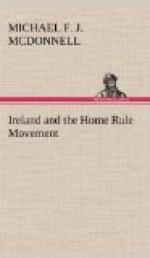The ridiculous situation which was allowed by successive Governments to persist in the Gaelic-speaking districts of the West until a few years ago, in which teachers were appointed to the schools without any knowledge of the only language spoken by the children whom they purported to educate, is well illustrated by the statement on the part of one of their number to the effect that it took two years to extirpate, to “wring” the Irish speech out of the children and replace it, one must suppose, by English, and this process, it must be remembered, was gone through with the children of a peasantry whom a distinguished French publicist—M.L. Paul-Dubois—has described as perhaps the most intellectual in Europe.
It is characteristic of English government that, whereas from 1878 onwards Irish figured in the programme of the National Board, and Government grants were made for proficiency therein as in other subjects, one of the last acts of the late Government was to withdraw these grants for the teaching of Irish. So long as there was no large number of people anxious to learn Gaelic in Ireland, Government gave help towards its study, but the very moment in which, with the rise of the Gaelic League, the number learning the language began to increase, Government put its foot down and proceeded to discourage it by a withdrawal of grants. The order effecting this was withdrawn by Mr. Bryce. The signal failure of the attempts made to kill the Gaelic movement with ridicule, on the part of those who saw in it an evil-disposed attempt to stop the Anglicising of the country, was as conspicuous as has been the ill success of the petty tyranny of the Inland Revenue authorities, who took out summonses against those who had their names engraved on their dogs’ collars in Gaelic. Trinity College has had for half a century two scholarships and a prize in Gaelic attached to its Divinity School, and the fact that the ultimate trust of the fund of its Gaelic Professorship on cesser of appointment is to a Protestant proselytising society shows the interest which has actuated the study of Gaelic in that foundation, and its attitude towards the Gaelic League found expression in Dr. Mahaffy, one of its most distinguished scholars, who, having failed to kill the movement with ridicule, changed his line and declared that the revival of Gaelic would be unreasonable and dishonest if it were not impossible.
In spite of this, the success of the League, which was only established in 1893, is astonishing. In 1900 it consisted of 120 branches; to-day there are more than 1,000. The circulation of Gaelic books published under its auspices is over 200,000 a year. In the year 1899 it was taught in 100 Primary Schools, it is now taught in 3,000.
The number of people, including adults, learning Irish in evening continuation classes was in 1899 little over 1,000, and is to-day over 100,000.




